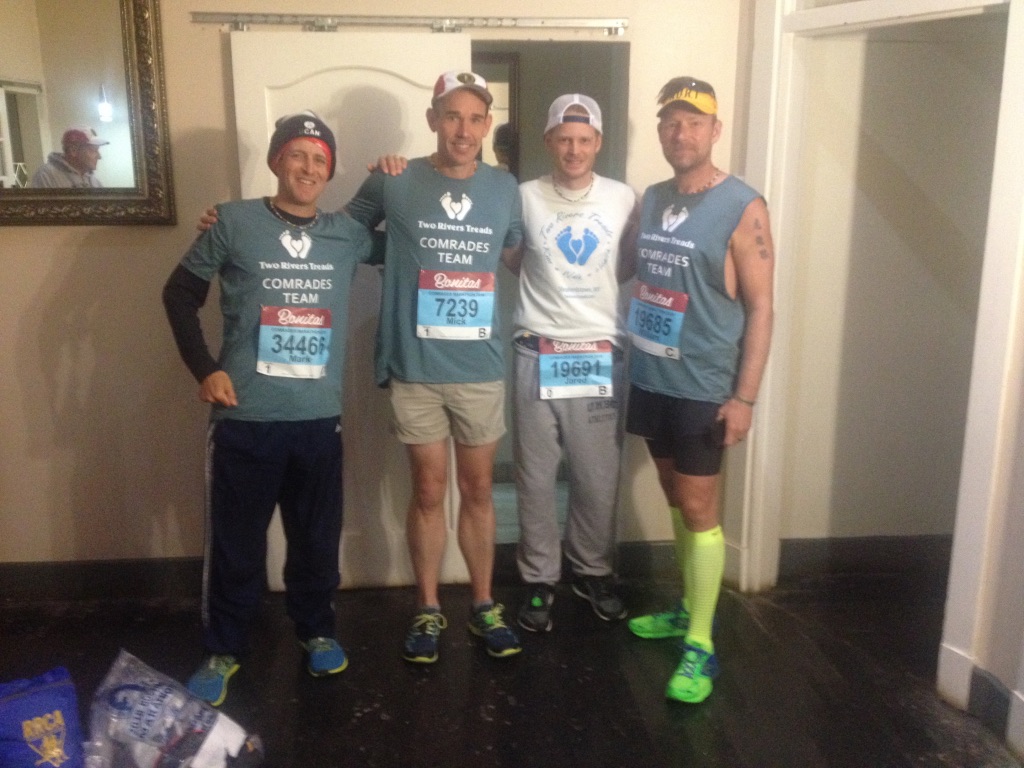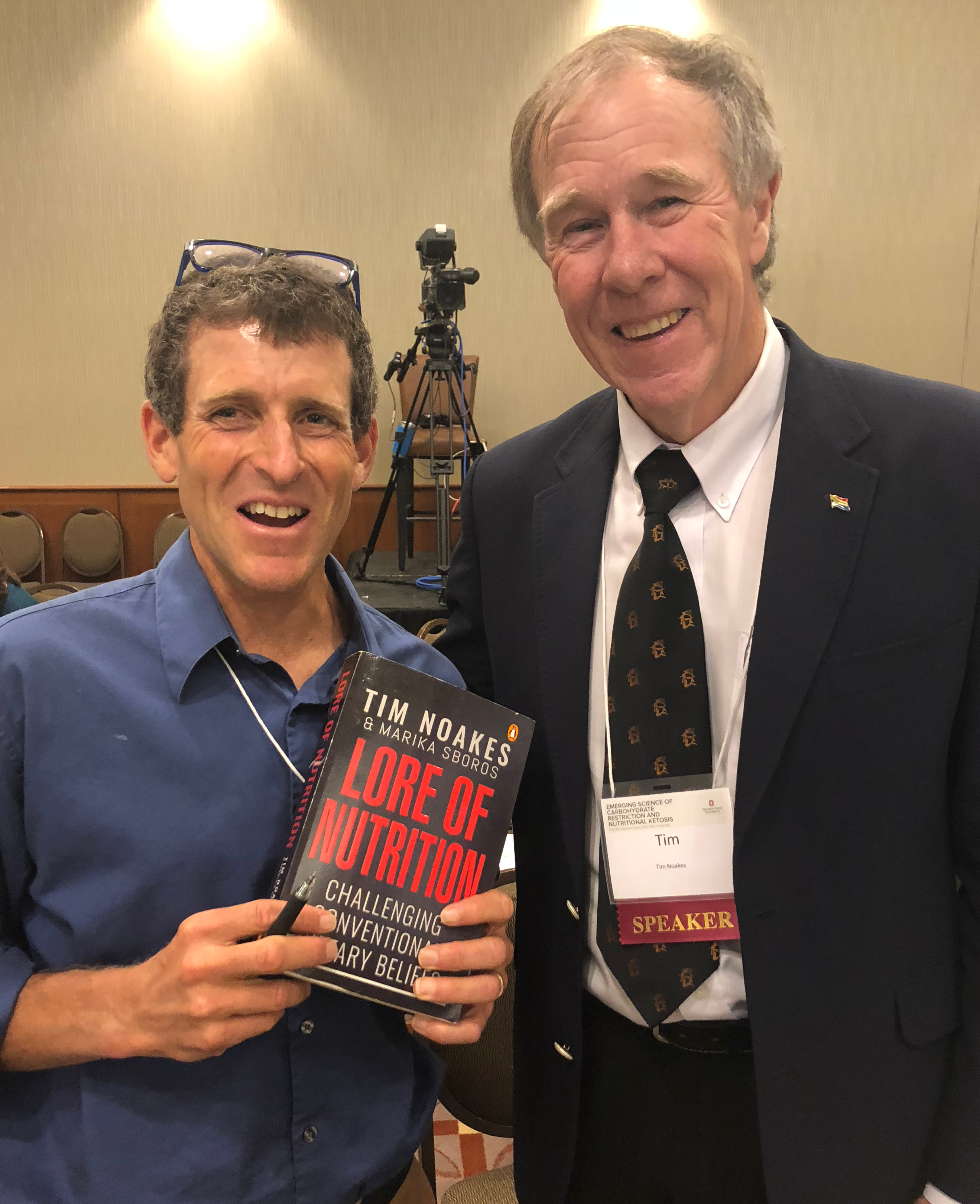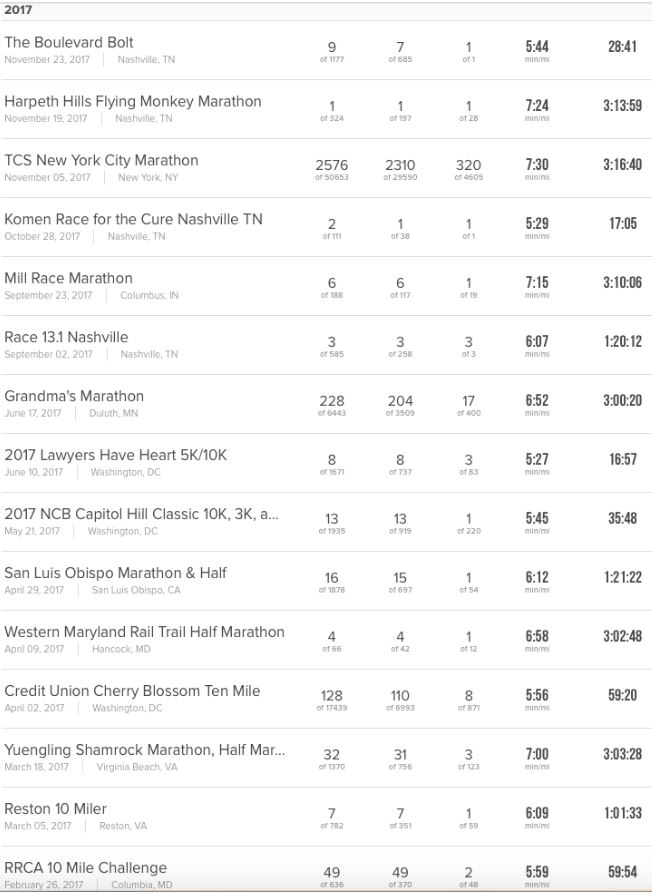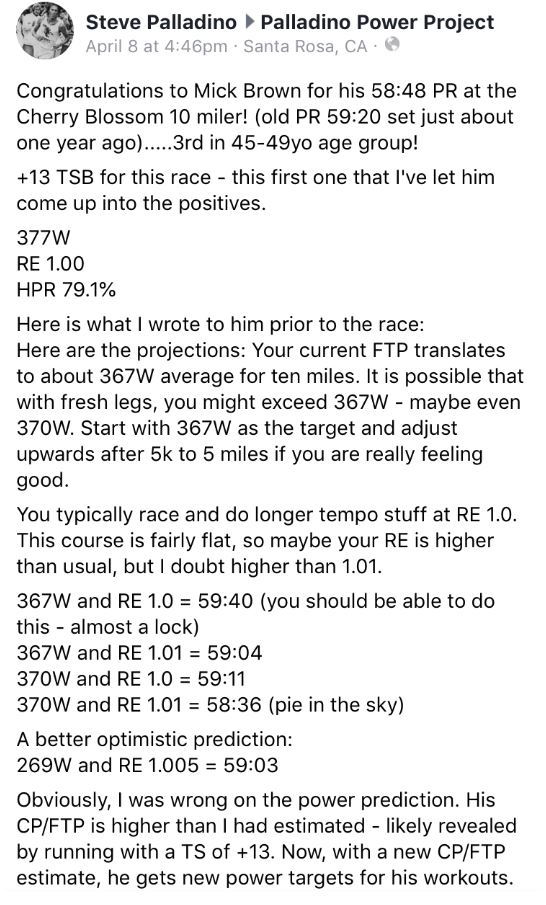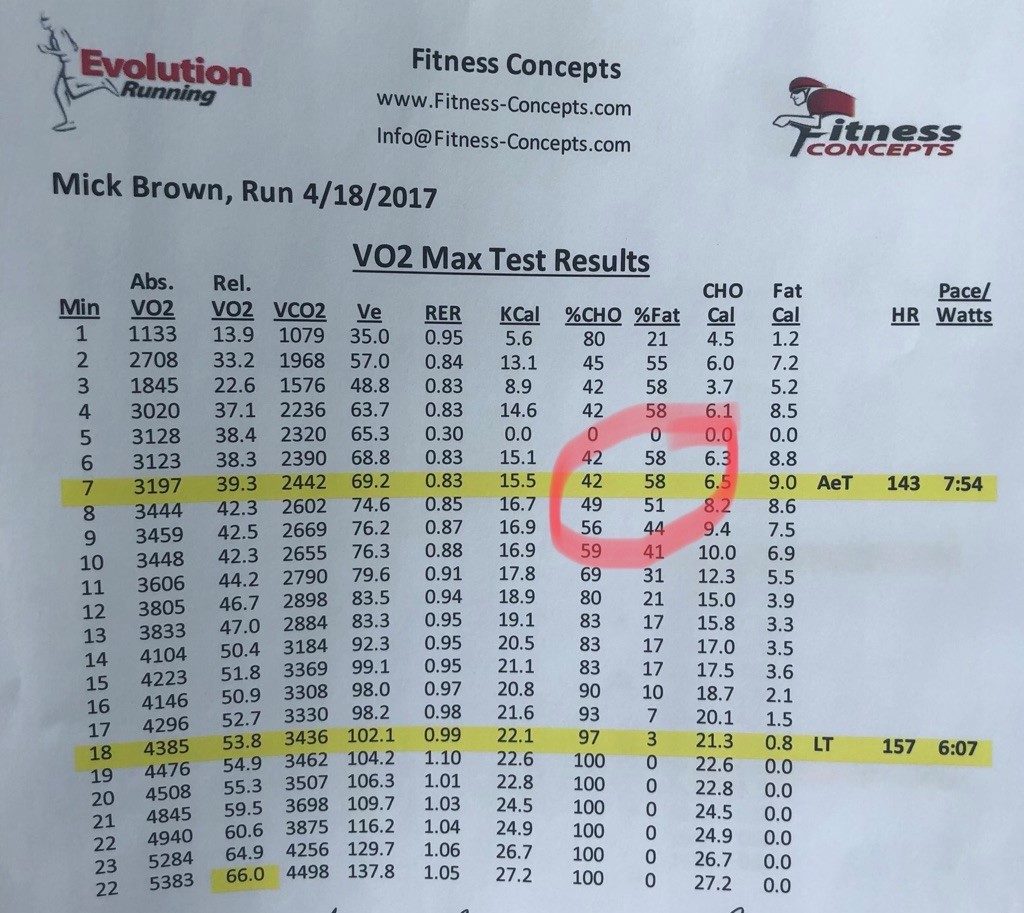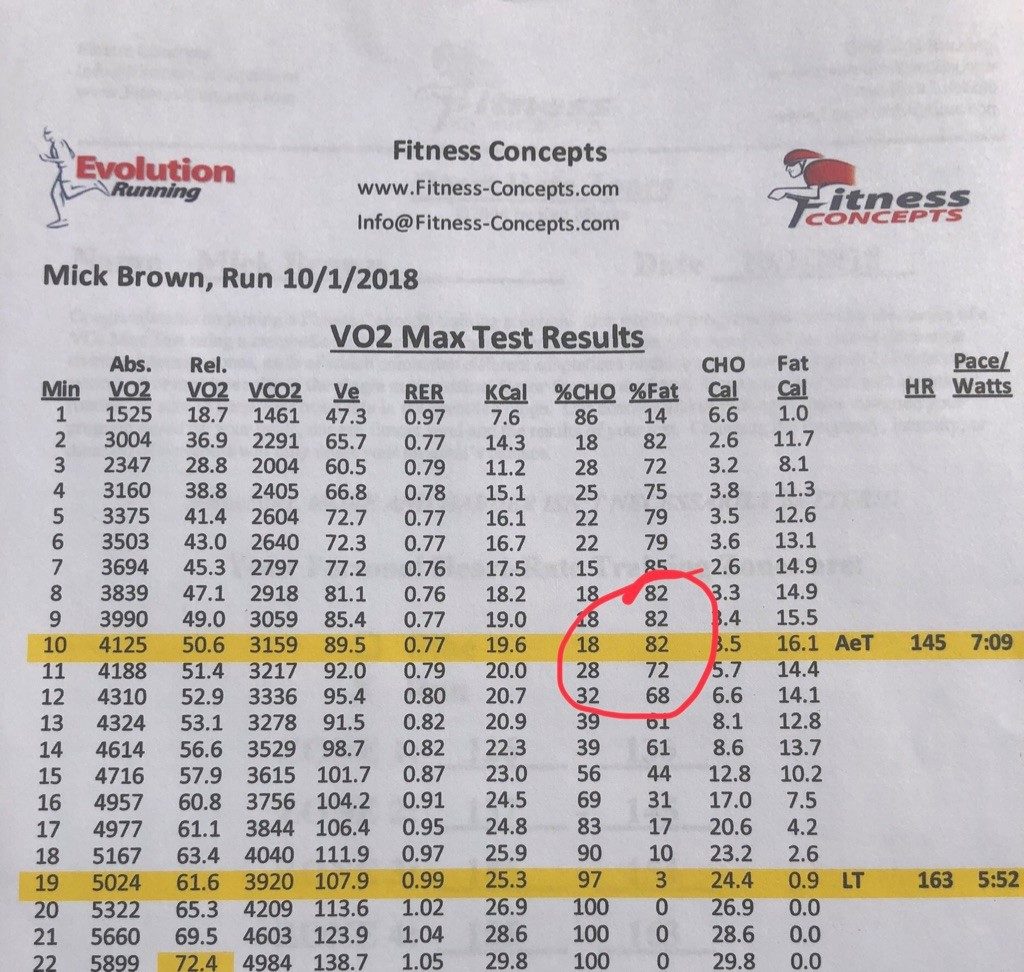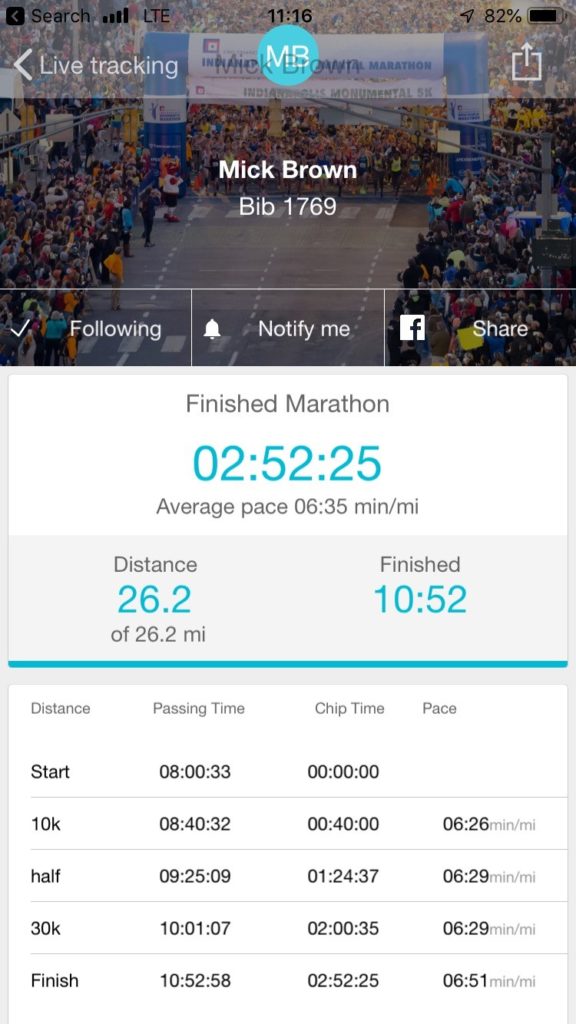This week sharing the continuing story of my good friend Mick Brown who is a constant source of interesting and challenging information in my life. He has also been an uber volunteer for our race Freedom’s Run. Thanks Mick for sharing!
……………………………………………………………………………………………………………………………………………………….
It’s more than 18 months since first posting on this website http://naturalrunningcenter.com/2017/05/19/mick-brown-aka-aussie-clydesdale-natural-running-odyssey/ for my good friend, Dr Mark Cucuzzella. A lot has transpired in that time. I moved to Nashville, the company for which I work was acquired and I ran Comrades Marathon http://www.comrades.com in South Africa for the second time last June.
18 months on, I decided to provide an update: what’s changed, what’s worked? What else have I learned and what’s next?
That last blog entry came shortly after I attended one of Dr Mark’s ‘Healthy Running’ https://www.healthfitu.com courses in San Luis Obispo, CA, where I was fortunate enough to spend some time with the erudite Dr Phil Maffetone https://philmaffetone.com Phil guided the great Mark Allen through all those Hawaiian Ironman victories in the late 80s into the early 90s and is an inspiration to those seeking to run healthily and injury-free. I’ve benefited so much from his insights, which have helped me improve my performances over time. Fun fact, Dr Phil was also treating Johnny Cash in the later stages of his life.
Without doubt, one of the highlights of 2018 was my attendance at this conference, Emerging Science of Carbohydrate Restriction & Nutritional Ketosis, conducted at the Ohio State University in August: https://u.osu.edu/ketodiet/ My primary motivation for attending was to hang out with Dr Mark as well to meet some of the people who are working tirelessly to shift the mindsets of entire populations pertaining to diet and public health. Prof Tim Noakes, author of Lore of Running, Waterlogged, and, more recently, The Real Meal Revolution and Lore of Nutrition, was the keynote speaker, while other luminary speakers included Nina Teicholz, author The Big Fat Surprise and Gary Taubes, author of The Case Against Sugar. While these individuals are relatively high-profile individuals, the line-up of speakers, which included an oncologist, exercise physiologists, endocrinologists and a neurologist was an all-star cast.
It is worth noting, however, that these are people who are not seeking to cash in on their fame or their clinical expertise. If anything, while they’re passionate about effecting meaningful change, you wouldn’t encounter a more laid-back, self-effacing group of people.
This is me with Prof Noakes, a delightful individual, single-minded, some might even say, dogmatic, in challenging conventional wisdom.
Here’s Prof Noakes with Dr Mark after signing his book.
Another highlight was meeting Nina Teicholz. Nina’s book The Big Fat Surprise https://thebigfatsurprise.com is a New York Times bestseller, which has received favorable reviews by both the Wall St Journal and The Economist : She’s a compelling speaker, a smiling assassin whom the sugar lobby and the processed food cabal should rightly fear.
More on that conference later.
Leading up to that post from 2017, there were some key changes I had made, including:
- Elimination of sugar and a transition to more of a low-carb, high fat (LCHF) diet, although as I will explain later in this post, I still wasn’t ‘all in’ with the approach
- Moving away from ‘carbo loading’ pre-race and limiting intake of carbs during long runs and in marathons
- Slowing down on almost all of my training runs, adopting the principles of the Maffetone Method https://philmaffetone.com/maf-gps-test/
- Introduction of walk breaks to aid in freshness and recovery
- Focus on hip flexibility and core strength
I had already run 2 marathons, and 4 x 10-miler races as the goal race of Grandma’s Marathon https://grandmasmarathon.com in Duluth, MN, approached in June, 2017. And while I lowered my 10km PR from 36:06 to 35:48 and my 5km PR from 17:00 to 16:57 in the month leading up to Grandma’s, the marathon itself wasn’t a great outing for me that warm and humid June day and I stumbled across the finish line in 3:00:20.
The Maffetone Method
Following a couple of weeks off after Grandma’s, I wanted to see what would happen if I trained almost exclusively by heart rate, with a handful of quality sessions interspersed throughout the build-up to the New York City Marathon https://www.tcsnycmarathon.org in November, 2017. Using the Maximum Aerobic Function (MAF) Formula of Dr Maffetone https://philmaffetone.com/maf-gps-test/ I trained for a full six weeks almost exclusively by my target heart rate of 140 beats per minute (bpm). If my HR exceeded 140, I would slow down until it was back under that threshold. With the heat and humidity, combined with the undulating terrain near where I now live in Nashville, it was difficult to discern much improvement in that initial phase (perhaps that why Dr Maffetone likes to refer to it as the ‘patience phase’). What was interesting, however, was when I did step out onto the track, it was as though I hadn’t skipped a beat in terms of speed. It was still there!
The first sign of validation came a full two months after training primarily by heart rate with the Nashville 13.1 in September, 2017. I didn’t really have any expectations when I toed the start line on a mild to warm day but was pleasantly surprised when I crossed the finish in third place in 1:20:13, an improvement over my previous best time for a half of 43 seconds, which had stood since 2012. A few weeks later, I ran/ walked a marathon in Columbus, IN in 3:10:06 in red flag conditions, while a week before the NYC Marathon, I punched out 17:02 for a 5km, missing my PR by only 5 seconds. Again, this was on very little speed work, indicating that with the aerobic adaptations, the speed comes naturally. It’s counter-intuitive, I know, but for most of us, we can make meaningful, sometimes dramatic, progress without risking injury, through a combination of training primarily in the recovery and aerobic zones and reducing the intake of processed carbohydrates.
NYC was a bad day at the office. I was feeling ‘off’, logging a 3:16:40, my slowest marathon in over five years. While disappointed, I did, however, feel confident that with the continued focus on this approach, the gains would manifest themselves in due course.
Two weeks after NYC was the Flying Monkey Marathon http://www.harpethhillsmarathon.com, organized by my quirky, sadistic pediatrician friend from Vanderbilt, Dr Trent Rosenbloom. Entry into this iconic race, run in the spectacular Edwin Warner and Percy Warner State Parks and with 3,600 ft of total elevation change, is decided by a combination of subjective factors which Trent won’t share. My goal for the Monkey, as it’s known, was to finish it, have fun, and check off another state.
As anybody who runs in Percy Warner will attest, despite the stunning scenery, the park is not exactly a ‘fun’ place to run. Even on an ‘easy’ day, it’s an honest workout. Given those dynamics, my goal was to run the Monkey by heart rate. I figured that as long as I kept my heart rate below what I knew to be my lactate threshold, 157 bpm, I probably wouldn’t ‘bonk’. My fueling approach had also been evolving. Whereas I used to take 3 – 4 gels (Gu) during marathons, I would now take a VESPA pouch https://www.vespapower.com pre-race and then another 1 – 2 during the race. VESPA’s value proposition is to help the fat adapted athlete leverage their fat burning capabilities while making strategic use of carbohydrates during a race. I’ve been training and racing with these supplements for two years now. On this particular day, I was able to complete this race with only 4 sips of Gatorade and no gels.
With that heart rate-based approach, I managed to stay strong and fresh throughout, and with a couple of miles to go, I passed the lead runner to finish in a time of 3:13:59 for the win (alas, the win comes with an asterisk, as the runner who should have won was directed off the course and decided to drop once he found out). I was even happier with the fact that my splits were even, and my average heart rate was 154 bpm, less than the ceiling which I had set myself of 157 and only 11 beats higher than my aerobic threshold of 143 bpm established in my baseline VO2 max test the preceding April.
Four days later, on Thanksgiving, was the Boulevard Bolt 5-miler, along the hilly Belle Meade Boulevard. With no running since the Monkey, I still managed to log 28:41, a PR of 80 seconds off my previous best over that distance.
Overall, 2017 was one of my best years ever. Six marathons at an average of 3:07:54, four of which were run/ walk efforts. Four 10-Milers, shaving 57 seconds off my PR. I lowered my half PR from 1:20:57 to 1:20:13, my 10km PR from 36:06 to 35:48 and my 5k PR from 17:00 to 16:57.
More importantly, I was learning that I could increase the mileage significantly, with fewer rest days, less intensity and race better through a combination of improved diet and more active recovery.
Running with Power
It was the day before NYC Marathon when I caught up with my friend, Lindsey Parry, the official coach of the Comrades Marathon http://www.comrades.com in South Africa. Lindsey himself is an accomplished runner, in addition to being a renowned coach. He was telling me how he had started training by power, using a power meter developed by a Colorado start-up called Stryd https://www.stryd.com One of my running friends had been using Stryd to great effect as well. Lindsey himself is a Maffetone aficionado. With his own athletes, he makes sure they adhere to the MAF formula on their easy/ recovery days although he prescribes actual workouts based on power because of the greater degree of specificity.
My interest piqued, I purchased a Stryd for myself before seeking out more information on the power-based approach to training, settling on Coach Steve Palladino to help me plan out my training. Steve, a former 2:16 marathoner and a retired podiatrist living in Santa Rosa, trains his athletes exclusively by power. Not being inclined towards physics and mathematics, I’m the last person to explain running with power in layman’s terms, so I will direct the interested reader towards an overview of Steve’s coaching philosophy instead: https://blog.stryd.com/2017/08/17/steve-palladinos-training/
I had already signed up to run Comrades in South Africa in June of this year. I wanted my ‘down’ run medal to go with the ‘up’ run medal I earned in 2013. Now, all that remained was to embark on an interminable build up to the big day in June.
2018
As 2018 rolled around, Comrades training started in earnest. My training program called for a handful of marathons, none of which were goal races, as well as a half-marathon and a 10-miler as tune-ups. Gradually, my mileage increased so that I was regularly logging 80 – 90-mile weeks at the peak of my build-up. There would be one serious mid-week workout as part of a 15-mile run, while on weekends, we built up to marathon distance with threshold efforts of up to an hour incorporated, peaking at 30 miles for the overall distance.
All six of these marathons were training efforts, not raced, with run/ walk breaks every mile. These marathons would have prescribed work efforts at threshold pace e.g. 3 x 20:00 or 2 x 30:00 with 3:00 easy between, or 60:00.
What was most interesting in reviewing the data from these marathons was the fact that my heart rate was continuing to drop, relative to the speed and elevation change. These marathons were also run during 80 – 90-mile weeks. The day after a marathon would typically be a 10-mile recovery day, followed by a complete day off and then I would be back at it with mid-week tempo or interval sessions. While I also felt some fatigue, the recovery needed seemed to be less and less.
Other races
The half-marathon I raced in March was relatively early in the build-up and I was encouraged that I was at least able break 1:20. A month later, when I raced the Cherry Blossom 10-Miler in DC, I was even more excited as I shaved another 32 seconds off my PR of 59:20 to place 3rd in my age group in 58:48. This is where Coach Palladino’s expertise proved very helpful as we planned out race tactics.
Comrades Race Recap
Comrades Marathon is an event which I will also cherish completing. To understand why, check out what happens just before the gun goes off at 0530 in the morning when the South African National Anthem is played: https://www.youtube.com/watch?v=qYkP_CA7pwA As I stated earlier, I was excited to run the ‘down’ in 2018 and while I came nowhere near to hitting my goal time of 7:30 to earn a silver medal (my time was 8:05 over the 56 miles) and was even more relieved for the race to be over. I’m not given to lengthy race reports, so I’m going to direct the reader to Dr Mark’s fantastic recap instead: http://naturalrunningcenter.com/2018/08/05/comrades-2018-running-comrades/
Nutritional Ketosis Conference
I must admit that when I turned up to this conference at Ohio State in August, 2018, I knew little about nutritional ketosis. While generally subscribing to the tenets of a low-carb, high fat diet, the term ‘keto’ carried with it connotations of weird people. However, the epiphany I experienced after listening to the presenters, from Prof Noakes, Nina Teicholz, Gary Taubes, Dr Jake Kushner, Dr Andrew Mente, Dr Ron Krause, Dr Steve Phinney and Dr Jeff Volek among others made my attendance worthwhile. It was amazing to learn how pediatric patients with type 1 diabetes or epilepsy would experience pronounced improvement in their overall health through adhering to a ketogenic diet.
These people are the real deal. I had learned a year earlier about Volek and Phinney and their seminal F.A.S.T.E.R. study which had validated the ‘fat is fuel’ philosophy: https://www.sciencedirect.com/science/article/pii/S0026049515003340 What’s even more impressive is how their work, along with others like Dr Sarah Hallberg of Indiana University, has led to the formation of a telehealth company, Virta Health https://www.virtahealth.com . Virta places type 2 diabetes patients on a pathway involving a ketogenic diet, coupled with personalized counseling. Their initial results have been quite encouraging, with large numbers of patients experiencing improved wellbeing while reducing prescribed medications. The company has already raised 45Mil with the potential to sell their platform to health plans and employers alike.
At the time of this conference, I had already resolved to eliminate bread, rice and pasta completely from my diet. As I said in my last blog post, moderation is difficult for me. It’s an all or nothing proposition when it comes to sugar and bread in particular. This conference convinced me that I was on the right path. I thought I had little to lose by embracing the approach in the lead-up the goal race, the Indianapolis Monumental Marathon in November.
VO2 Max Test
After almost 3 months following a ketogenic diet (typically restricting my carbohydrate intake to less than 75g per day), I was excited to see how my results would compare with the baseline established in April of last year. I traipsed out to see Ken Mierke of Fitness Concepts http://fitness-concepts.com in Falls Church, VA as I know he’s consistent in the protocol he uses for this test.
Once the test was over, Ken indicated that I would be pleased with the result, as evidenced by this summary:
My VO2 max had increased from 66 to 72, while my aerobic threshold (AeT) pace had dropped from 7:54 per mile to 7:09 per mile, while I was also burning more fat as a percentage of VO2 max. Likewise, my lactate threshold (LT) pace had dropped, while increasing from 157 – 163bpm and shifting upwards as a percentage of VO2 max. The most notable (and encouraging) sign was the fat oxidation at AeT (82% v 58% in the previous test).
While my training had been going exceedingly well, I don’t know how else to explain these numbers other than the dietary changes I had implemented. Processed carbohydrates increase the risk of inflammation, which in turns impedes recovery and potentially leads to overtraining, if one is not careful. I had reduced my carbohydrate intake significantly while simultaneously developing aerobic function. At an age where I should be slowing down, I was speeding up while learning to burn my body’s limitless supplies of fat. There’s little doubt in my mind that fat adaptation can yield dramatic results, and not just for endurance sports. What’s even more interesting is how an increasing number of elite sports teams which one would normally think require more anaerobic conditioning are also moving towards ketogenic diets because of the positive physiological changes in their athletes.
The human body is amazing in terms of how quickly it adapts to burning fat as fuel.
Going through the VO2 max test with Ken at Fitness Concepts
Baseline, showing aerobic threshold (AeT) at 143bpm with pace of 7:54 per mile. Burning 42% carbohydrate, 58% fat.
In this test, my AeT has increased from 143 to 145 bpm, at an average pace of 7:09 minute mile while fat oxidation is considerably higher compared with my baseline result.
Looking ahead
To close the book on 2018, I completed my final goal race, the Indianapolis Monumental Marathon. The marathon is the one distance where my personal best time is soft, relative to my PRs over the shorter distances. For this particular event, I was hoping that I would be somewhere around 2:47; however, on a perfect day, I was significantly off, while still managing to book a new personal best of 2:52:25, an improvement of 2 ½ minutes. Aerobically, I felt fine the entire time, but it’s clear that my biomechanics require some improvement. A sub-2:50 looked within reach through 30km and that’s when the fade started, and my form broke down. I know what I need to do to remedy this, and I’m fortunate that I have friends like Dr Lawrence van Lingen who have helped me understand the importance of hip extension and mobility as a means to running more efficiently. In Nashville, I’ve started working with a movement specialist, Pate Young, who has been trained in an approach called dynamic neuromuscular stabilization developed by the Prague School: https://www.rehabps.com/REHABILITATION/DNS.html Years and years of poor posture are not easily undone, but after a month of working with Pate, I’m already noticing considerably improved trunk rotation and breathing as a result of learning to use my diaphragm.
In Conclusion
2018 was one of my best running years ever, with PBs in the 10-miler, half-marathon and marathon. From NYC 2017 to Indy 2018, I completed 9 marathons plus Comrades, as well as a bunch of races over shorter distances. I don’t feel as though I pounded my body into submission, but there are times where a period of ‘deep recovery’ is beneficial and there’s no doubt that I needed a complete break from training as well as more focus on recovery and aerobic running. As my 47th birthday approaches, recovery takes on even more importance. It’s been almost 3 years since I was forced to take off more than a couple of days of running, and I’m hoping to maintain the streak through focusing on the basics.
Running with power has definitely helped me become much more dialed in for workouts and races. The power numbers don’t lie, and despite my best efforts to prove Coach Palladino wrong, I’ve learned to trust in the process and (most of the time) complete workouts and races per the prescribed targets.
What’s also been gratifying is seeing continued improvement and results from piecing everything together that I have learned from people like Dr Mark, Prof Noakes, Dr Maffetone, and Dr van Lingen. My only regret is that I didn’t sit up, take notice and follow their advice years ago when I was first exposed to their respective approaches. More importantly though, these are individuals whom many would consider to be out of the mainstream. I’m in awe of them because of their commitment to improving the health of populations with little focus on personal financial aggrandizement. They are giants to me. My hope is that I am able to pay it forward.

